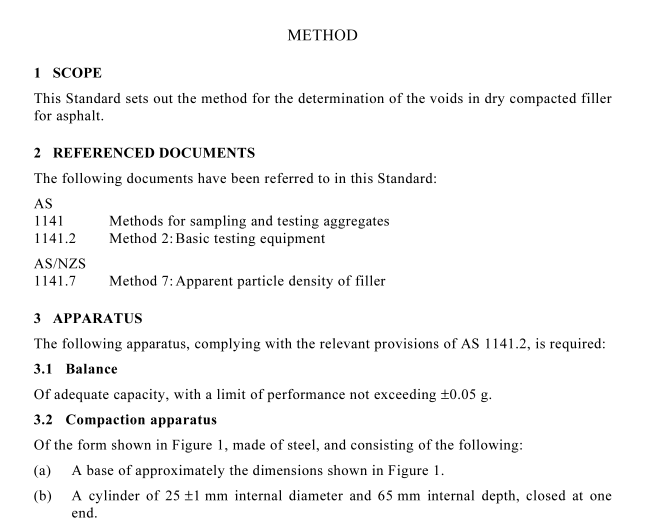AS NZS 1141.17 pdf download – Methods for sampling and testing aggregates Method 17: Voids in dry compacted filler

AS NZS 1141.17 pdf download – Methods for sampling and testing aggregates Method 17: Voids in dry compacted filler
1 sCOPE
This Standard sets out the method for the determination of the voids in dry compacted fillerfor asphalt.
2REFERENCED DOCUMENTS
The following documents have been referred to in this Standard:AS
1141
Methods for sampling and testing aggregates
1141.2
Method 2: Basic testing equipment
AS/NZS
1141.7
Method 7: Apparent particle density of filler
3 APPARATUS
The following apparatus, complying with the relevant provisions of AS 1141.2, is required:3.1Balance
of adequate capacity, with a limit of performance not exceeding ±0.05 g.3.2Compaction apparatus
Of the form shown in Figure 1, made of steel, and consisting of the following:(a)A base of approximately the dimensions shown in Figure 1.
(b)A cylinder of 25 1 mm internal diameter and 65 mm internal depth,closed at one end.
(c) A ram or plunger of such diameter as will allow it to slide freely in the cylinder with minimum lateral play, provided with a hole to allow air to escape. The hole, about 5 mm in diameter, shall be drilled axially from the top to about 13 mm from the bottom. From the bottom upward the hole shall be about 1.5 mm diameter and about 1.5 mm off-centre, meeting the hole drilled from the other end. The plunger shall have a circumferential groove about 6.5 mm from its lower end to accommodate filler that works up the side of the cylinder while in use. The mass of the plunger shall be 350 ±2 g.
(d) Means for raising the cylinder and dropping it freely between vertical guides from a height of 101.5 ±0.25 mm to the base. The total mass dropped onto the base shall be 850 g to 900 g, including the filler.
(e) Means for reading the depth of the compacted filler in the cylinder to an accuracy of 0.1 mm. The compaction apparatus shall be used dry, without lubricant on any part. During use the apparatus shall be held or clamped firmly on a rigid, level, non-resilient support; a position above the leg on a firm bench is recommended.
3.3 Desiccator Containing anhydrous silica gel. NOTE: A convenient size is 200 mm to 250 mm diameter.
3.4 Oven Thermostatically controlled, to operate at a temperature of 105°C to 110°C.
4 NUMBER OF DETERMINATIONS Three determinations of the percentage dry voids shall be made, using a separate test portion of filler for each determination. If any of these values differs by more than 1.0% from the mean percentage, that value shall be discarded and two further determinations shall be made.
5 DETERMINATION OF APPARENT PARTICLE DENSITY The apparent particle density of the filler, ρ , shall be determined in accordance with AS/NZS 1141.7, on a subsample of the material being tested.
6 PROCEDURE
The test procedure shall be as follows:
(a) Dry the filler for 4 h in the oven at a temperature of 105°C to 110°C and cool it to room temperature in a desiccator.
(b) Pour about 10 g of the dried filler into the compaction cylinder and distribute it uniformly in the bottom of the cylinder by tapping it gently on the bench.
(c) Pressing a finger onto the central hole in the plunger to prevent ejection of the filler from the cylinder, insert the plunger and allow it to slide slowly onto the filler. Apply pressure to the plunger so as to form the filler into a slightly compacted bed.
(d) Remove the plunger without disturbance of the filler, wipe excess filler from the plunger and sides of the cylinder, and clean the hole through the plunger if necessary.
(e) Clamp the base or otherwise firmly hold it on a firm level surface free from vibration or resilience. Reinsert the plunger and place the cylinder gently in position on the base.
(f) Raise the cylinder, with plunger in position, and allow it to fall freely through a vertical height of 101.5 ±0.25 mm to the base. Repeat the process until 100 drops have been completed. The plunger shall remain free to move in the cylinder throughout this operation, and to ensure this it shall be eased frequently by twisting it in the cylinder and, if necessary, removing it and wiping it clean of clogging filler.
(g) After 100 impacts, if necessary gently lift the plunger, turn it, and place it back on the filler bed so that the result can be read. Read the depth (D) of the compacted filler to the nearest 0.1 mm.
(h) Dismantle the apparatus without damaging the bed or filler, and wipe the outside of the apparatus clean of any adhering compacted filler.
(i) Remove the filler forming the compacted bed and determine its mass
(m) to the nearest 0.01 g.









